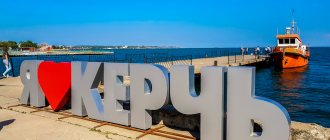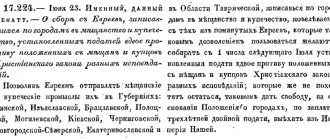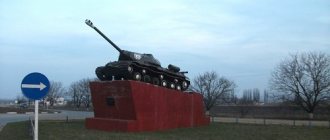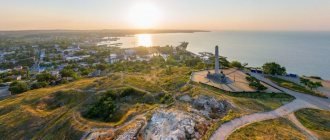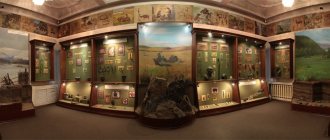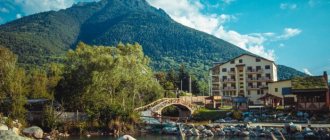The beginning of the war - the attack on the Kerch Peninsula
The Second World War came to Kerch in the summer of 1941. Two brigades are being formed in the city - the people's militia and the destroyer battalion. In the first months of the war, more than 1,500 volunteers and more than 15 thousand conscripts went to the front. Thousands of Kerchan residents of non-conscription age – young boys and girls – are joining the people’s militia.
The evacuation of civilians began in August, and of industrial enterprises in September. Despite the shortage of equipment and personnel, the Kerch Metallurgical Plant continues to produce flamethrowers, grenades, mortars, and anti-tank incendiary mixture for the front. In the first months of the war, the plant produced two armored trains.
Kerch Metallurgical Plant 1942 Source: waralbum.ru
Advanced German units enter Crimea on September 12 and begin an offensive in the direction of the Kerch Peninsula. Kerch is one of the main strongholds of the peninsula. From here the path to the Taman Peninsula and the Caucasus was open for the Nazis.
Focke-Wulf FW-190 aircraft
Since October, the city begins to be bombed daily by Lutwaffe planes. Since October 27, real hell has been happening in Kerch. More than 600 air bombs are dropped on the city, the railway junction and port are completely destroyed. Kerch burned for several weeks.
On November 4, the Kerch defensive region was created, which includes the Kerch naval base and units of the 51st Army. But this no longer helps stop the enemy. By this time, Soviet units were holding out on the Kerch Peninsula with all their strength.
The KVMB observation post was located on the Mithridates Stairs. Source: waralbum.ru
There was only one way out - to save the army’s equipment and weapons. Otherwise, the Germans will inevitably defeat the remnants of the troops and move on - to Taman and to the Caucasian oil.
The command decides to evacuate troops on November 14. Retreating, Soviet troops blow up fuel depots, a floating dock, the Voikov plant, a water supply system, and power plants.
Several dozen civilian ships and fishing seiners are transporting about 50 thousand soldiers and over 400 guns from Kerch to Taman. The evacuation takes place under constant fire from enemy artillery and mortars.
Entertainment in Kerch
Those who love entertainment more than viewing historical antiquities will also not be bored in Kerch. Entertainment establishments operate both in the center and in the suburbs. Tourists coming to the city should visit:
- children's Disneyland;
- amusement park;
- a unique poultry farm where ostriches are raised.
A tour of the poultry farm must be booked in advance. Here you can take interesting photos and watch birds.
Disney Park
Disney Park is a popular family holiday destination, modeled after European Disneylands. Here you can visit an amusement park, celebrate a birthday, take pictures with life-size puppets depicting children’s favorite characters from popular cartoons and fairy tales. If the weather is bad, you can go to game centers.
Entertainment programs and master classes for children and teenagers are regularly held on site. There are quiet relaxation areas for parents with children under three years old, and several small cafes where you can have an inexpensive and tasty snack.
Children's amusement park
The children's amusement park is located right on the Kerch embankment, so you can combine entertainment with a beach holiday. One of the main attractions of the park is a huge Ferris wheel, which is clearly visible from different points of the city. After a ride on the wheel, you can admire the views of Kerch from a bird's eye view and take interesting photos. The park is divided into several zones: for children with parents under 3 years old, for preschool children, for schoolchildren and teenagers.
Ostrich farm
This place will certainly appeal to children and adults. The ostrich farm is the only farm in Russia where you can see real live ostriches. Exotic birds thrive in the local climate and lay eggs regularly. Here you can watch the life of birds and their feeding.
The farm is located near the ferry, which acts as a ferry from Kerch to the Caucasus, in the village of Podmayachny. Ostriches arrived here in the early 2000s, amid increased interest in exotic animals and agriculture. There are organized tours of the farm, a café, and ostrich-related souvenirs such as miniature ostrich eggs. The guide will tell you about the life of ostriches, what they eat, and what benefits they bring to humans.
First occupation: mass destruction of civilians
The Germans begin to rule the city on November 16th. The occupation of the city lasted only six weeks. But they were remembered by the civilian population as one of the most terrible periods of the war.
A column of German soldiers on the street of Kerch during the parade. November 27, 1941. Source: waralbum.ru
At this time, mass executions of the population took place. First of all, the SS task force begins registering and exterminating Jews, Gypsies, communists, Crimeans, and Komsomol members.
The Nazis began their monstrous atrocities with the poisoning of 245 schoolchildren. Then followed the tragedy of the Bagerovsky ditch - the Nazis tortured and killed over 7 thousand civilians.
Kerch. Gymnasium No. 2 (formerly women's gymnasium). The place where the Nazis poisoned 245 innocent children.
The building of the oldest gymnasium in Kerch after restoration.
This massacre site was discovered in January 1942 by Soviet troops. The ditch, 4 meters wide and 1 kilometer long, was overflowing with the corpses of women, children, and old people.
Kerch. Bagerovsky ditch. Photo "Grief". Source: waralbum.ru
How many civilians died during these month and a half in Kerch is still not known for certain. The Nazi atrocities in Kerch became one of the terrible episodes of the Nuremberg trials.
Residents of the city from the very first days of the occupation began to fight against the enemy. Back in early November, during the period of evacuation of Soviet troops, two partisan detachments were formed in the city - Starokarantinsky and Adzhimushkaysky. Quarries become hiding places for partisans. The struggle against the invaders underground continues until the liberation of the city by Soviet troops at the end of December 41st.
Kerch. Adzhimushkay quarries. Memorial ensemble at the entrance to the quarries
Kerch. One of the entrances to the Starokarantinsky quarries
Monument to border guards in Adzhi-Mushkai
And again the “tragic” Adzhi-Mushkay. Not far from the memorial group and the underground museum “Adzhimushkai Quarries” we will meet an ensemble consisting of a boundary pillar and a memorial slab with an inscription (all this is placed on a granite pedestal, where a staircase leads). The object is visible in the wasteland. You won't get lost.
The complex is dedicated to the front-line soldiers of the 95th Border Regiment, who fell in two military operations at once near a populated area. The object was reconstructed in 2010 (before that there was only a pillar). There are still a lot of monuments dedicated to the Second World War in the city of Kerch, for example, to Soldiers-Aviators, Paratroopers, a composition in Voykov Park, etc.
On topic: Museums of Kerch
Pay attention to the photo. The WWII monuments in Kerch are dedicated to both the soldiers of that terrible war and its victims among the local population. Some compositions are positioned so that they are clearly visible from the sea, and from afar. Reviews call the city we described as “the place of Glory of several wars at once.” Appreciate each work of monumental sculptors. As a rule, their works are shown by guides. In conclusion, we offer an educational video, enjoy watching.
Liked? Share with your friends!
First liberation of the city: Kerch-Feodosia landing
The Soviet command could not come to terms with the loss of the Kerch Peninsula. In a short time, a liberation plan was prepared: amphibious landings in Feodosia and Alushta and a forced march to the Ak-Manai Isthmus. The operation began a week before the New Year.
The landing was complicated by bad weather in the Sea of Azov and the Kerch Strait. By the evening of December 26, the storm intensified to almost 7 points - the torpedo boats were flooded and thrown from side to side.
Severe frost (-15 degrees) formed an edge of ice near the shore, which prevented the boats from approaching. Under enemy artillery fire, the paratroopers had to jump straight onto the sandbank and go on the attack in chest-deep icy water. They carried light guns, equipment and ammunition ashore on their hands
The landing force lands in the area of Kamysh-Burun, Stary Karantin and Eltigen. But they manage to gain a foothold only on the Kamysh-Burun Spit, on the former pier of the ship repair plant.
For two days the paratroopers held back the enemy onslaught. They suffered huge losses and were already preparing for the last battle. But on December 28-29, 11 thousand soldiers, mortars, machine guns, and cannons were transferred to help them.
On the night of December 30, scouts who penetrated Kerch discovered that the Germans had abandoned the city and retreated to the west. The first occupation of Kerch is completed. At the same time, Soviet troops landed in the Feodosia area.
The transfer of Soviet troops to the Kerch Peninsula continued until January 3, 1942. At this time, to the surprise of the old-timers, the strait froze, and a route was immediately laid on the ice. 300 guns, 6 thousand vehicles, 6 rifle and 1 cavalry divisions were transferred along the ice road to Kerch.
Red Navy soldiers are conducting surveillance on the roof of a house in liberated Kerch (the first liberation of the city). Source: waralbum.ru
Liberated Kerch becomes a military base for Soviet troops in Crimea. The enemy understands this too. Enemy air raids do not stop in the city; Soviet anti-aircraft guns are constantly fighting from the ground.
In these conditions, active activities are carried out at the enterprises of Kerch. Workers at the Voikov plant repair guns, tanks, cars, manufacture ammunition, and build a new armored train for the front. Vessels with military cargo for units of the Soviet Army depart from the berths of the Kerch port.
Kerchan residents want to believe that they have finally returned to peaceful life. The city's water pumping station is being restored, the newspaper is starting to be published again, and several city schools and bread stores are opening. But soon the Great Patriotic War returns to Kerch again.
Public transport in Kerch
Public transport works well. People go to Kerch:
- Taxi;
- buses;
- trolleybuses;
- trams;
- water transport.
Buses in Crimea run on a schedule; it usually appears at the stops. Most routes go through the city center and past the city's major beaches. In some cases, getting to a place by bus is more convenient than by car, because there are no traffic jams.
Second attack on Kerch: “Hunting for Bustards” and “Soviet Dunkirk”
The site has a full article “Hunting Bustards”
On January 28, a new Crimean front is created - the smallest in length and one of the shortest in the history of the Great Patriotic War.
Headquarters orders to launch an offensive and completely liberate Crimea. But the troops of the Crimean Front, trying to advance three times (from February 27 to April 13), were never able to push back the Wehrmacht troops. In January 1942, the Germans reoccupied Feodosia.
The High Command gives the order to stop the offensive and create a strong defense in Kerch. At the end of May, the Crimean Front was supposed to go on the offensive again, but Hitler’s troops were ahead of the General Headquarters’ plan.
Beaches
The beaches in Kerch are a favorite vacation spot for tourists and local residents. There are both secluded corners and noisy, lively beaches with a wide range of entertainment, as well as specially designated areas for diving and other water sports.
Judging by the reviews of tourists, most beaches are well equipped and landscaped. There is a rescue service on duty everywhere around the clock. The water temperature during the season reaches 22 - 23 degrees. There are both sand and pebble beaches. Sun loungers and umbrellas can be rented.
Kerch defensive operation or “Hunting for Bustards”
Operation "Hunting for Bustards".
Documentary footage from the German historical archive On March 28, 1942, Hitler announces a new summer campaign. The plan to seize the Kerch Peninsula receives the code name “Hunting for the Bustard.”
For the first time, powerful Wehrmacht equipment - tanks and heavy artillery - is being sent to Crimea. And German submarines and torpedo boats begin to operate in the Black Sea.
By this time, the Crimean Front had about 250 thousand soldiers, and had a fairly impressive arsenal of military equipment. But the Soviet command did not prepare for defense, contrary to the decree of Headquarters.
Soviet troops do not have strong defensive lines and are gathered “in a heap.” All three armies stand behind each other's heads in open areas - a huge number of troops and equipment are concentrated in one place.
On the night of May 7–8, the Germans launched a massive artillery and tank attack on a concentration of Soviet troops. The soldiers of the Red Army fight selflessly, but the forces are unequal, and the position of our troops is not advantageous. Most of the command posts were immediately destroyed by the Germans, and communications among the troops were disorganized.
In just three days, the Nazis break through the Crimean Front in the center of the Turkish Wall, where the highway to Kerch passes.
By the evening of May 13, the enemy begins to actively bomb the city - more than 2 thousand bombs fall on Kerch on that day alone. On May 14, German troops reached the shore of the Kerch Strait in several places and captured Mount Mithridates.
Officially, the second occupation of Kerch begins on May 15, 1942. But in fact, the city did not give up its position for several more days. There were fierce battles on the streets of the city, every house was turned into a fortress.
Until May 18, fighting takes place on the territory of the Voikov plant. Here, groups of Red Army soldiers and factory workers isolated from the troops resisted until the last fighter. An armored train built at the plant also takes part in the battles.
On May 20, the last heroic defenders of Kerch died - about 2 thousand soldiers who fought on the territory of Yeni-Kale.
Soviet Dunkirk
The evacuation from Kerch was not organized and took place in a hurry. At first, only the wounded, artillery and Katyushas are taken out. Then the removal of the remaining troops and population began.
We managed to find 158 ships for evacuation - the “Tulkin fleet”. It mainly consisted of seiners, minesweepers, longboats, and tugs. And not all of them were in good condition.
Covering the retreat, the remaining units fought to the end. But thousands of people – civilians and military – gathered on the shores of the Kerch Strait. And it was clear that there was not enough space on the ships for everyone.
Logs were knocked together on the shore, homemade rafts were built, and floats were made. Many tried to escape by swimming. There were screams and moans above the shore. And all this under constant enemy bombing.
There were no analogues to what was happening in the entire history of the Second World War.
According to the Soviet command, about 140 thousand people managed to evacuate through the Kerch Strait. Approximately 17 thousand of them crossed independently.
Second occupation: bloody page in the history of Kerch
Having captured the city for the second time, the Germans begin to deal with the population with even greater cruelty. Already on May 19, the Nazis began mass executions of the male population. Kerch during the occupation turns into a bloody massacre.
Not having time to cross to the Taman coast, entire families of Kerchan residents go to the quarries. But this does not help them hide from the horrors of the occupation.
In May 1942, a total of about 15 thousand military personnel and local residents gathered in the Adzhimushkai quarries. Here they fought the enemy for more than 6 months - without water and food, in the deep darkness of a cold dungeon, under constant enemy fire.
Inside the quarries
The feat of the Adzhimushkais went down in the history of the Great Patriotic War as one of the most terrible and heroic episodes. Now the Adzhimushkay quarries are a memorial to the Second World War in Kerch, one of the terrible monuments of the war.
But it was not only the heroic Adzhimushkai who fought the fascists. For several months the struggle continued in the Bulganak, Starokarantinsky, Bagerovo quarries and in the ruins of the Voikov plant. The names of most of these defenders still remain unknown.
On the territory of the Kerch Peninsula, partisan detachments and underground groups spontaneously arise. First, they are formed from local residents and Red Army soldiers who did not have time to leave the city. The fight against the fascists is becoming widespread in Kerch.
In conditions of severe surveillance and mass repression by the fascists, the Kerch underground fighters manage not only to issue propaganda leaflets, but also to carry out sabotage. They more than once organize escapes of prisoners of war from transit camps that the Germans organized at Serpentine Cape and at the Engels Club.
- In December 1942, embittered fascists carried out brutal massacres:
- about 2 thousand civilians were killed in Adzhimushkai;
- Almost a thousand people were shot in the mine of the plant named after. Voikova;
- over 400 people were burned alive in the factory's engineering and technical personnel club.
The Nazis are transporting young people over 13 years old en masse to Germany. About 14 thousand Kerchan residents were kidnapped by the Nazis during the second occupation. For refusing to leave, teenagers were shot on the spot.
In just 17 months of the secondary occupation in Kerch, about 15 thousand civilians died from starvation and executions.
Museums of Kerch
Kerch (Crimea) is a place that is often called a “museum city”. And these are not just beautiful words: there really are many objects of cultural and architectural heritage, as well as protected museum areas. Lovers of high art will certainly enjoy visiting the following objects:
- Historical and Archaeological Museum;
- Art Gallery;
- Lapidarium.
If you want to take a fascinating excursion with your family or a large group, you should call the museum’s contact number in advance and order excursion services for a specific time. It should be borne in mind that at the height of the tourist season, it is possible to make an appointment several days or even a week in advance, due to the large influx of vacationers.
You can visit museums on your own at any time by checking the opening hours on the website. Some Kerch museums provide additional paid services for listening to audio tours.
Art Gallery
It is based on an exhibition of paintings by local artist Nikolai But and bears his name. The exhibition halls are located in a building built in the classicist style. The entrance to the art gallery is framed by an antique portico of four columns.
Both works by local artists and interesting artifacts found during archaeological excavations in the city are exhibited here. One of the exhibition halls houses a diorama dedicated to the Church of John the Baptist.
Historical and Archaeological Museum
Previously, this museum was called the “Kerch Museum of Antiquities.” Here you can see exhibits found during archaeological excavations in Kerch and other cities of Crimea. Four halls are occupied by an exhibition dedicated to the history and archeology of the Bosporus; exhibits from primitive times are presented here: tools of the Neolithic and Paleolithic era, as well as artifacts of material culture found in local burial complexes. Among the most interesting exhibits are grape and wheat grains that are two thousand years old.
Museum of the History of the Eltigen Landing
The museum arose in 1985, the grand opening was timed to coincide with Victory Day in the Great Patriotic War. The exhibition tells about the liberation of Kerch from the fascist invaders and the role the Kerch-Eltigen military operation played in the victory.
The Crimean-Eltigen landing performed an amazing feat, defending against the enemy for a month during an almost complete blockade. The fighters demonstrated an amazing example of courage and fortitude. One of the main heroes of the operation was Major Dmitry Koveshnikov.
Lapidarium
The word "lapidarium" is translated from Greek as "storage of stones." Here you can see unique hand-made products made from stone, primarily from limestone. The exhibition began to take shape in the 19th century.
There is also a souvenir salon on the territory of the museum, where you can purchase stone figurines and other works of decorative and applied art. The cost of a ticket for adults is 120 rubles, for schoolchildren - half as much. In the exhibition you can see ancient stone slabs with drawings carved on them.
Liberation of Kerch and the Kerch-Eltigen landing operation
At Soviet Headquarters, plans for the liberation of Crimea have been developed since October 43rd. It was decided to attack the enemy from two sides - from the north through Perekop, and from the east through the Kerch Strait. A plan for the Kerch-Eltigen operation is being developed in a short time.
On the night of October 31 to November 1, 1943, Soviet troops simultaneously began landing troops in the northeast of Kerch and in the area of the village of Eltigen. This landing operation is considered one of the largest in the history of the Second World War.
As with the first liberation of Kerch, three thousand paratroopers were immediately unlucky. A strong storm begins at sea. And again the fighters have to go on the attack in the icy wind and rain.
Kerch-Eltigen landing operation. Kerch. 1943.
The landing force manages to fully land in the area of the fishing village of Eltigen only in the evening of November 2. And on November 3, the Soviet command transferred about 9 thousand soldiers, artillery, and mortars to Eltigen.
Landing of a detachment of Marines from the 83rd battalion. Kerch-Eltigen landing operation. 1943 Source: waralbum.ru
The Germans are throwing all their strength into defeating the daring landing. And already on November 4, enemy troops completely took control of the Kerch Strait, cutting off a handful of fighters from the help of Soviet sailors.
Our troops manage to hold a small piece of land on Eltigen for 26 days. The paratroopers are suffering huge losses, they lack ammunition and weapons. They decide to break through to the center of Kerch. By the morning of December 7, Soviet soldiers occupied Mount Mithridates. But they cannot remain in these positions for long. The surviving paratroopers retreat from the city four days later.
Subsequently, the Eltigen bridgehead would be called “Tierra del Fuego,” and during the Soviet years the village of Eltigen would be renamed Geroevskoye. For participation in this operation, 129 soldiers were awarded the title of Hero of the Soviet Union.
The Eltigen bridgehead served as a diversionary maneuver. For a while he completely captured the attention of the Germans. This allowed another landing group to land in the northeast of Kerch.
On November 2, the landing of Soviet troops began in the area of the villages of Gleika and Zhukovka. First, about 9 thousand people with heavy guns, mortars, ammunition and food are landed here. In just a few days, almost 28 thousand people are transferred to this area.
Transfer of military equipment during the Kerch-Eltigen landing operation
The landing force manages to cover a section of the coast of the Azov Sea right up to the outskirts of Kerch. Soviet soldiers failed to take the city, but they held out here until the Crimean offensive operation.
The Red Army made the next attempt to liberate Kerch on April 8, 1944. This time she was successful. 5 German and 7 Romanian divisions could not withstand the onslaught of Soviet troops that broke through Perekop. And on April 11, 1944, at 6 o’clock in the morning, General Eremenko’s troops entered the city.
- By this time, almost nothing remained of the city:
- In Kerch, more than 85% of residential houses and buildings were destroyed.
- By November 1943, the Germans forcibly evicted the remaining residents.
- The territory of the city was turned into a huge fortified area.
The liberators were met by only 30 people - the entire remaining population of Kerch .
Residents of Kerch, after liberation, look at a stand with photographs about the atrocities of the Nazis who carried out reprisals against the civilian population of the city during the occupation. “They spared neither the elderly, nor women, nor children” is one of the inscriptions on the stand.
Sights of Kerch
This southern city has a lot to offer. There are numerous travel agencies in Kerch where you can contact and book an excursion. Tourists are taken on sightseeing tours around the city, and are also offered to visit specific places. It is definitely worth visiting such tourist sites as:
- Kerch Fortress;
- Great Mithridates Staircase;
- Tsarsky Kurgan.
There are also many parks and green areas for a relaxing family holiday.
Adzhimushkay quarries
The quarries are a unique historical monument of the Great Patriotic War. Then fierce battles broke out between the Nazis and the Russians. In total, more than 13,000 people died in the stone catacombs.
Now there is a defense museum here (address: Brothers Malchenko St., 34-36). The guide will talk about how people survived underground and show artifacts preserved here from those memorable times. Individual visits are prohibited, as you can easily get lost in the Adzhimushkai quarries. You should take a flashlight with you.
Mount Mithridates
The Obelisk of Glory on Mount Mithridates is one of the most popular places for tourists to visit and take photographs in Kerch. The height of the mountain is more than 90 meters. If you climb to its top, a wonderful view of the surrounding area will open up.
Mithridates is located in the historical center. People lived here in ancient times. Previously, there was a Greek city called Panticapaeum. Under the mountain there are a large number of underground passages, in which, according to legend, there are ancient burials in the form of crypts.
The mountain got its name from the Pontic king, who once ruled in this area. You can get to Mount Mithridates, one of the main attractions of Kerch, by any public transport.
Great Mithridatic Staircase
A huge staircase is located in the main square of the city and leads to the top of Mount Mithridates. This staircase is often depicted on commemorative postcards and magnets, eagerly purchased by tourists. It took seven whole years to build this unique structure.
The staircase was restored several times after the Crimean War of the 19th century and the Great Patriotic War. In the 1960s, the original sculptures of griffins were recreated on the observation deck. The Mithridates Staircase is a majestic architectural structure; it is clearly visible from different points of the city.
Kyz-Aul lighthouse
One of the oldest lighthouses in the city, it is located among extensive sandy beaches and looks very picturesque. The lighthouse was built 143 years ago. The octagonal black and white tower is visible from afar and is one of the main architectural dominants of Kerch, its landmark.
The architectural ensemble includes a glacier, an underground room for storing food supplies and a house in which the keeper of the Kyz-Aul lighthouse used to live. Nearby is the flooded floating dock of a Soviet ship that sank during the Great Patriotic War.
Yenikalsky lighthouse
Located in a village called Podmayachny, it is the eastern cape of the Crimean peninsula. Back in 350, the first landmark for sailors was built here, but only in 1820 the lighthouse received its modern name.
The original architectural structure was destroyed during the war, when the Nazis fired at Kerch from the sea. In 1953, a new complex was built here. The Yenikalsky lighthouse is active, you can get here with an organized excursion.
Yenikale Fortress
This fortress was built by the Turks in the 18th century in order to protect their state from the Russian fleet. Yenikale is located at the narrowest point of the Kerch Strait. In the 19th century, it housed a hospital for soldiers wounded during the Crimean War.
During the Great Patriotic War, the architectural complex was partially destroyed. Now the ensemble includes fortress walls, entrance gates, and a semi-bastion. The gate is located in a massif of rocks, from here you can see the entire fortress and take beautiful panoramic photographs.
Kerch Fortress
There is a unique fortress in Kerch, which used to be of strategic importance and was used to protect the city from attacks by hostile neighbors. Now the fortress is just a historical monument, but it has retained its former power and will certainly impress tourists.
This fortification is located on Cape Ak-Burun; the fortress project was developed by the famous Russian architect Totleben, obeying the instructions of the Russian Emperor Alexander II. The Kerch fortress represents a powerful defense of the city from the south and covers an area of 420 hectares.
This is a specially protected site of federal significance and one of the best-preserved fortresses of Tsarist Russia. You can visit the Kerch attraction on your own or with an organized excursion.
View this post on Instagram
Posted by
